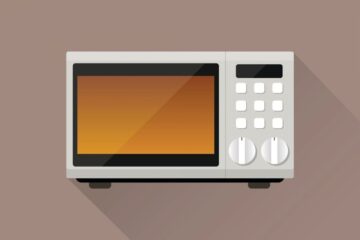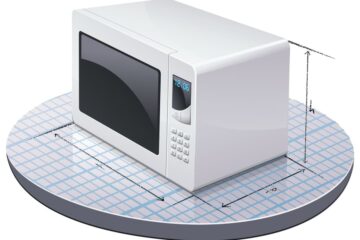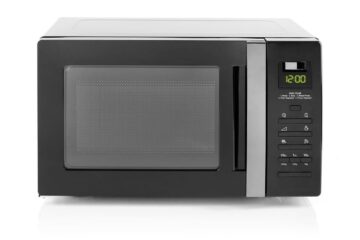Microwave ovens have become an indispensable part of modern kitchens, making cooking and reheating food quicker and more convenient. However, one aspect that often gets overlooked is their weight. Understanding the weight of a microwave oven is important for several reasons, including portability, durability, power consumption, and safety.
In this comprehensive guide, we will explore the various factors that affect the weight of microwave ovens, from their types and sizes to their materials, features, and accessories, and provide practical tips on measuring, carrying, cleaning, and disposing of them.
Microwave Oven Types and Sizes
Microwave ovens come in various types and sizes, each designed for different purposes and spaces.
Countertop Microwaves
Countertop microwaves are the most common type of microwave ovens, designed to sit on a kitchen counter or table. They are available in a range of sizes, from compact models that can fit on a dorm room desk to larger ones that can handle family-sized meals.
Over-the-Range Microwaves
Over-the-range microwaves, also known as above-range microwaves, are designed to be mounted above a stove or cooktop. They come in a range of sizes and styles, from basic models that simply function as a microwave to more advanced models that can also serve as a range hood or convection oven.
Built-in Microwaves
Built-in microwaves are designed to be integrated into a kitchen’s cabinetry or wall. They are available in various sizes and styles, from small models that fit into a cabinet to larger ones that can be installed at eye-level.
Compact Microwaves
Compact microwaves are designed for smaller spaces, such as dorm rooms or apartments. They are usually smaller in size and have fewer features than larger models.
Size Variations
The size of a microwave oven can have a significant impact on its weight. Generally, the larger the oven, the heavier it will be. However, other factors, such as the material and features, can also affect the weight.
Factors Affecting Microwave Oven Weight
Several factors can affect the weight of a microwave oven, including its material, capacity, features, and accessories.
Material
The material of a microwave oven can have a significant impact on its weight. Most microwave ovens are made of metal or plastic, with metal being the heavier option. However, some models use a combination of metal and plastic to balance weight and durability.
Capacity
The capacity of a microwave oven, or the amount of food it can hold, can also affect its weight. Larger ovens with higher capacities are generally heavier than smaller models.
Features
The features of a microwave oven, such as convection heating or grill functions, can also affect its weight. More advanced models with multiple features are generally heavier than basic models.
Accessories
Accessories, such as racks or trays, can also add to the weight of a microwave oven.
Average Weight of Microwave Ovens
Microwave ovens can vary greatly in weight, depending on their type, size, material, capacity, features, and accessories.
Statistics and Data on Weight Ranges
According to industry data, the average weight of a countertop microwave oven is around 30 pounds, while the average weight of a built-in microwave oven is around 60 pounds. Over-the-range microwaves typically weigh between 50 and 80 pounds, while compact microwaves can weigh as little as 20 pounds.
Weight Comparison Between Different Types and Sizes of Microwave Ovens
Comparing the weight of different types and sizes of microwave ovens can help you choose the one that best fits your needs. For example, a compact microwave may be more suitable for a small living space or for travel, while a heavy-duty built-in microwave may be more suitable for commercial use.
Measuring the Weight of Microwave Ovens
Measuring the weight of a microwave oven accurately is important for several reasons, such as determining its portability or ensuring safe handling during transportation or disposal.
Tools Required for Measuring Weight
To measure the weight of a microwave oven, you will need a scale or a balance. Digital scales are more accurate and easier to read than mechanical scales.
Steps to Measure the Weight Accurately
To measure the weight of a microwave oven accurately, follow these steps:
- Turn off and unplug the microwave oven.
- Place the scale or balance on a flat, stable surface.
- Place the microwave oven on the scale or balance, making sure it is centered and balanced.
- Read the weight displayed on the scale or balance.
Tips to Ensure Safety During the Process
When measuring the weight of a microwave oven, it is important to follow these safety tips:
- Use a scale or balance that can support the weight of the microwave oven.
- Avoid lifting or moving the microwave oven while it is on the scale or balance.
- Wear gloves or other protective gear, especially if the microwave oven is heavy or has sharp edges.
- Keep the scale or balance on a stable surface to prevent it from tipping over.
Heavy vs. Lightweight Microwave Ovens
When choosing a microwave oven, you may wonder whether to go for a heavy or lightweight model. Here are some pros and cons of each:
Pros and Cons of a Heavy Microwave Oven
Pros:
- Durability: Heavy microwave ovens are generally more durable and long-lasting than lightweight models.
- Power: Heavy microwave ovens often have more features and higher power ratings, allowing for faster and more efficient cooking.
Cons:
- Portability: Heavy microwave ovens can be difficult to move or transport, especially if you need to move them up or down stairs.
- Cost: Heavy microwave ovens are often more expensive than lightweight models, due to their larger size, more advanced features, and higher quality materials.
Pros and Cons of a Lightweight Microwave Oven
Pros:
- Portability: Lightweight microwave ovens are easier to move or transport, making them ideal for travel or small living spaces.
- Cost: Lightweight microwave ovens are often more affordable than heavy models, due to their smaller size and fewer features.
Cons:
- Durability: Lightweight microwave ovens are often less durable than heavy models, and may need to be replaced more frequently.
- Power: Lightweight microwave ovens may have lower power ratings and fewer features, leading to slower and less efficient cooking.
Weight and Portability of Microwave Ovens
The weight of a microwave oven can have a significant impact on its portability, especially if you need to move it frequently or take it with you on trips. Here are some types of microwave ovens that are designed for portability:
Microwave Ovens for Camping and Travel
If you enjoy camping or traveling in an RV, you may want to invest in a portable microwave oven. These models are designed to be lightweight and compact, making them easy to transport and store. Some models can even be powered by a car battery or solar panel.
Microwave Ovens for Small Living Spaces
If you live in a small apartment or dorm room, you may want to consider a compact microwave oven. These models are designed to be space-saving and lightweight, making them easy to move and store.
Carrying and Transporting a Microwave Oven
When carrying or transporting a microwave oven, it is important to follow these tips:
- Use a dolly or cart to move the microwave oven, especially if it is heavy or bulky.
- Secure the microwave oven with straps or bungee cords to prevent it from tipping over or falling.
- Use gloves or other protective gear to avoid injury from sharp edges or hot surfaces.
Weight and Durability of Microwave Ovens
The weight of a microwave oven can have a significant impact on its durability and lifespan. Generally, heavier microwave ovens are more durable and longer-lasting than lightweight models. Here are some heavy-duty microwave ovens that are designed for commercial use:
Heavy-Duty Microwave Ovens for Commercial Use
Commercial microwave ovens are designed to handle heavy use and high-volume cooking. They often have larger capacities, more advanced features, and higher power ratings than residential models. However, they are also heavier and more expensive.
Weight and Power Consumption of Microwave Ovens
The weight of a microwave oven can also affect its power consumption. Generally, heavier microwave ovens require more power to operate than lightweight models. Here are some tips for choosing an energy-efficient microwave oven:
Relationship Between Weight and Power Consumption
When choosing a microwave oven, look for models that have a high energy efficiency rating. These models are designed to use less power while still providing efficient cooking. However, keep in mind that heavier models may still use more power than lightweight models, even if they are energy-efficient.
Energy-Efficient Microwave Ovens
Energy-efficient microwave ovens use advanced technology, such as inverter technology or sensor cooking, to reduce power consumption while still providing optimal cooking results. Look for models that have the ENERGY STAR label, which indicates that they meet strict energy efficiency guidelines set by the U.S. Environmental Protection Agency.
Weight and Safety of Microwave Ovens
The weight of a microwave oven can also affect its safety, especially if it is not handled properly. Here are some safety concerns related to the weight of a microwave oven, and tips for safe use and handling:
Safety Concerns Related to the Weight of a Microwave Oven
- Risk of injury: Heavy microwave ovens can be difficult to lift or move, increasing the risk of injury or strain.
- Risk of damage: Dropping or mishandling a heavy microwave oven can cause damage to the oven, as well as to floors, walls, or other surfaces.
Tips for Safe Use and Handling of a Heavy Microwave Oven
- Use a dolly or cart to move the microwave oven, especially if it is heavy or bulky.
- Secure the microwave oven with straps or bungee cords to prevent it from tipping over or falling.
- Use gloves or other protective gear to avoid injury from sharp edges or hot surfaces.
Recycling and Disposing of Microwave Ovens
When disposing of a microwave oven, it is important to follow proper recycling and disposal guidelines to avoid environmental harm.
Here are some tips for recycling and disposing of a microwave oven:
- Check local recycling programs: Many communities have special recycling programs for electronic waste, including microwave ovens. Check with your local waste management agency to find out if there are any recycling programs in your area.
- Donate or sell the microwave oven: If the microwave oven is still in good working condition, consider donating it to a local charity or selling it on an online marketplace. This can help keep the oven out of the landfill and give it a new life.
- Contact the manufacturer: Some manufacturers have take-back programs in place for their products. Contact the manufacturer of your microwave oven to see if they have any recycling or disposal programs available.
- Follow local landfill guidelines: If all else fails and you need to dispose of the microwave oven in the landfill, be sure to follow any local guidelines for electronic waste disposal. This may include removing the power cord or other hazardous materials before disposing of the oven.
In conclusion, the weight of a microwave oven can impact its portability, durability, power consumption, and safety. When choosing a microwave oven, consider factors such as your living space, cooking needs, and energy efficiency preferences. And when disposing of a microwave oven, be sure to follow proper recycling and disposal guidelines to minimize environmental harm.



